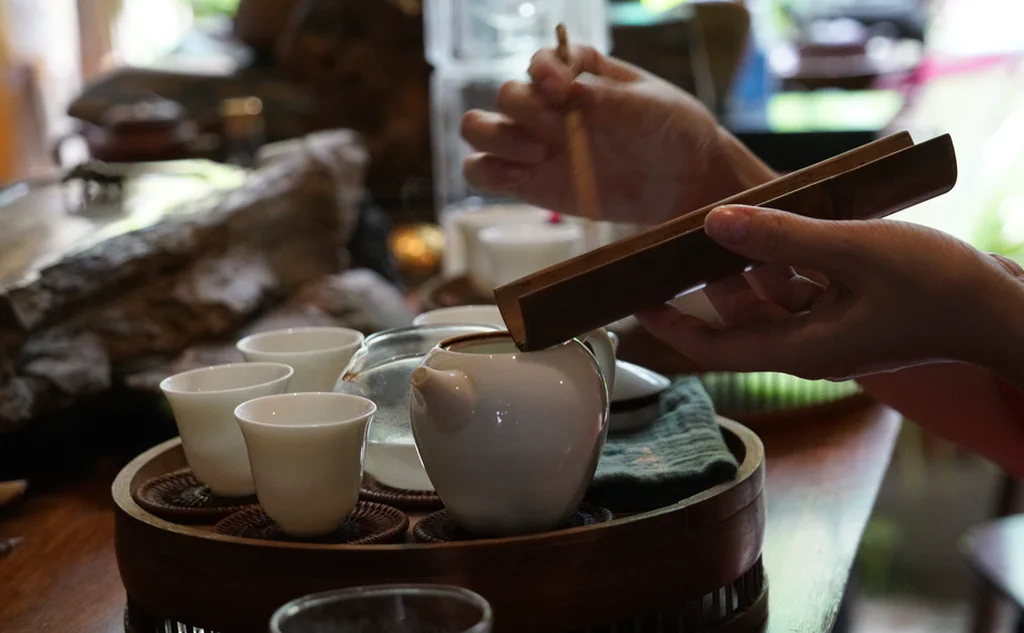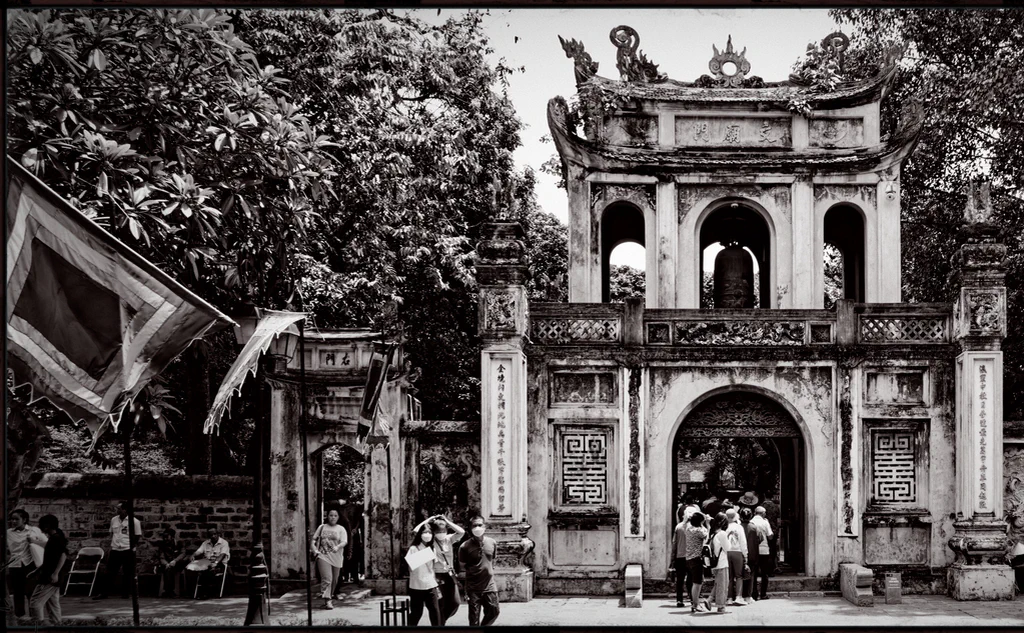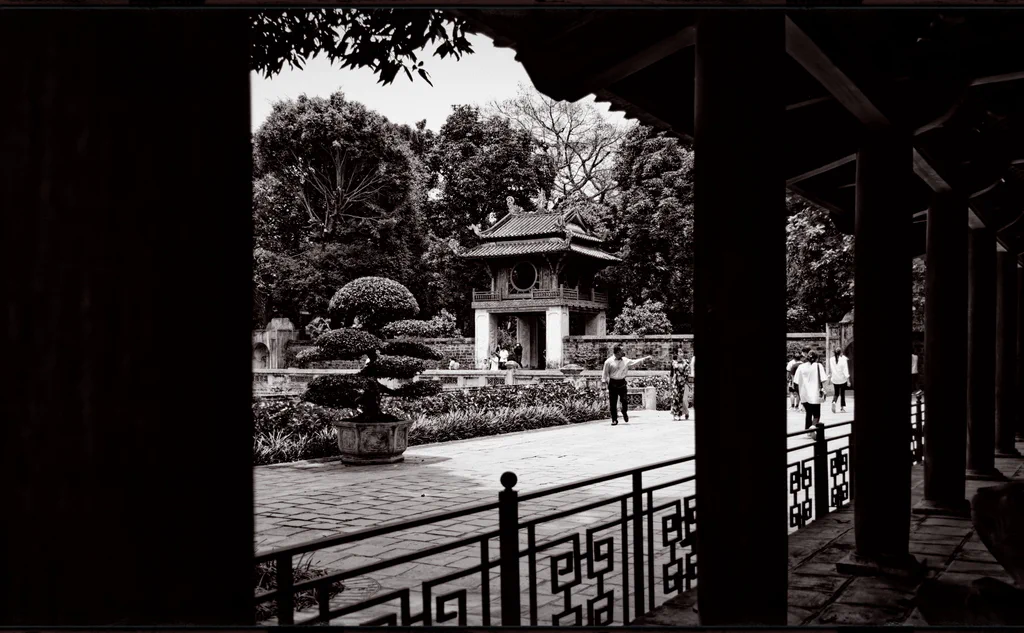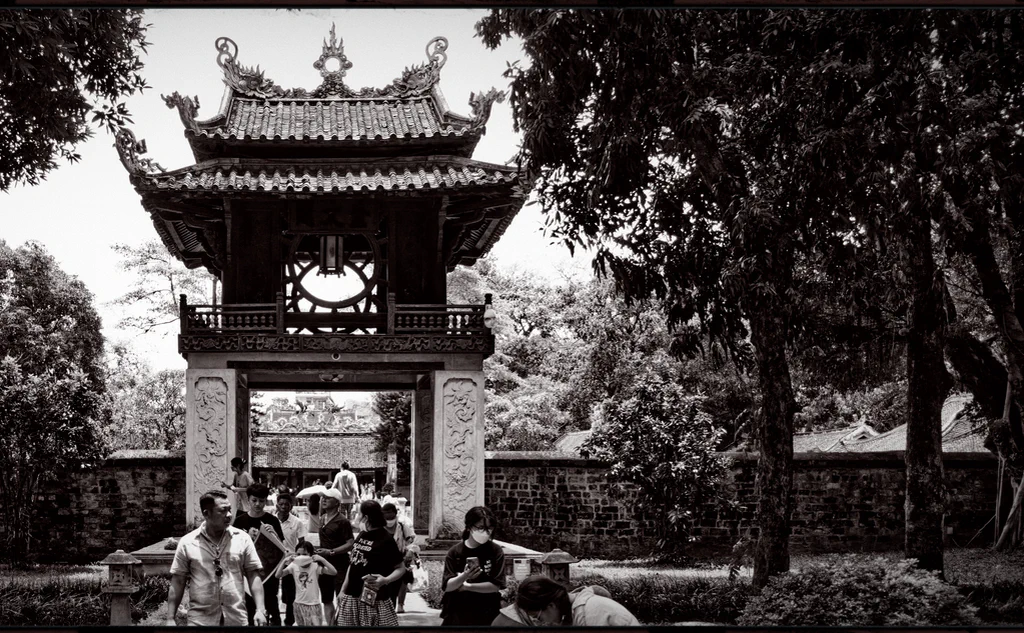Day 7 - 17th June
Tea Ceremony
Before we embarked on our walk through Hà Nội towards the Temple of Literature that day, the Vietnamese tea ceremony at the Hien Minh Tea House provided a welcome respite. This quaint, yet charming tea shop, tucked away in a nondescript side street of Hà Nội, is renowned for its calming ambiance and its excellent selection of local teas.
Upon entering the shop, we instantly felt transported to another world. The walls are adorned with dark wood, and the entire space is filled with teapots and cups of all shapes and sizes. At the back, an idyllic courtyard unveils, with several tables arranged around a small pond brimming with koi.
A lady gives us a warm welcome and begins to guide us through the ceremony. She moves with deliberate calm and precision; every gesture is intentional and graceful. There’s no rush; time seems to stand still as we observe the intricate process of tea preparation.
First, she heats the water in a small kettle, hanging above a charcoal fire. She explains that the water temperature must vary for each type of tea – overly hot water might scorch the delicate tea leaves, affecting the flavour.
As the water heats, she prepares the teapot and cups by rinsing them with hot water. This not only cleanses but also pre-warms the vessels, ensuring optimal tea brewing.
Next, she places the tea leaves into the pot and pours the hot water over them. The tea then steeps for several minutes before being poured into the finely crafted teacups.
Tasting the tea is an experience in itself. The tea she serves has a complex taste, striking a pleasant balance between bitterness and sweetness. She encourages us to sip slowly, allowing us to fully appreciate the myriad of flavours.
The Vietnamese tea ceremony is more than just a brewing process – it’s an art form demanding patience, precision, and respect for nature.
Temple of Literature
I stand at the entrance of the Khuê Văn Các, the Temple of Literature, which stands tall amidst the bustling heart of Hà Nội – a haven of tranquility amidst the urban tumult. Originally erected in 1070 and dedicated to Confucianism, this venerable site served as Vietnam’s first university. Yet, it’s more than just a place of worship – it’s a monument to education and literature, embodying the esteem this culture holds for knowledge and wisdom.
Upon entering, we’re greeted by meticulously manicured gardens. Lotus leaves float on the serene pond surfaces, whilst ancient trees and blooming shrubs provide a calm, verdant retreat.
The temple complex itself is a harmonious maze of five courtyards, connected by gates adorned with intricate carvings. I stroll along the cobbled paths, flanked by historic buildings boasting finely crafted wooden roofs and red brick walls.
One of the temple’s most striking features, however, is the depiction of turtles. Scattered throughout the site are several stelae resting atop stone turtles. In Vietnamese culture, the turtle symbolises longevity and wisdom. These stelae are engraved with the names of those who passed the demanding exams of the Royal Academy, standing as testimonials to education and scholarship.
Though the Temple of Literature has endured a long history of destruction and rebuilding, today it stands proudly as a testament to Vietnamese culture and education. Visiting this temple is both enlightening and soothing, reminding us of Vietnam’s profound history and tradition. Amidst the hustle and bustle of Hà Nội, they offer a genuine sanctuary for reflection and inspiration.
Ga Hà Nội, Train Station
Guided by Nicolas, we navigate through the maze of alleyways and backstreets. At times, it feels as though we’ve stumbled into a different Hà Nội, far from the tourist-trodden paths. The lanes are narrow and winding, lined with tall, closely-packed buildings, allowing only a sliver of sky to be seen. The heat is stifling, the humidity palpable. Rubbish accumulates in corners, its sweet-sharp scent mingling with the aromas of street food, motorbike exhaust, and ever-present dust.
Eventually, we arrive at Hà Nội’s main train station, the Ga Hà Nội. The term “Ga” is derived from the French “Gare,” meaning station – a relic from Vietnam’s French colonial period. Ga Hà Nội is the city’s main station and a crucial hub for rail travel throughout Northern Vietnam.
Despite the oppressive heat and humidity, it feels somewhat cooler here. We step into the station, but tread lightly. Nicolas reminds us that in Vietnam, train stations are considered strategic sites and cannot be casually photographed. The few snapshots we take are quick and discreet, not drawing the attention of the sparse crowd. We soon exit the station.
By Thien Quang Lake
After hours of sweating, photographing, and wandering exploration, we feel like wrung-out cloths – dehydrated, fatigued, with a veneer of dust and perspiration on our skin. We meander around the neighbourhood, searching for a restaurant recommended by Nico, which seems to no longer exist. I eventually suggest heading to one of Hà Nội’s gems, the Ngon Garden Restaurant.
The restaurant is an oasis. As we enter, a cool breeze greets us, instantly rejuvenating us. The décor is traditional yet modern. We settle down at one of the large wooden tables, our weary bodies gratefully sinking into the soft cushions of the seats.
The menu is a journey through Vietnam itself – dishes from all over the country are available, with a highlighted emphasis on fresh, locally-sourced ingredients. We order a medley – crispy spring rolls, aromatic Pho, spicy chicken dishes or seafood, accompanied, of course, by ice-cold Bia Hoi, helping us counter our dehydration.
As we dine, we exchange stories and impressions, gradually recovering. The day was taxing, but immensely rewarding.








